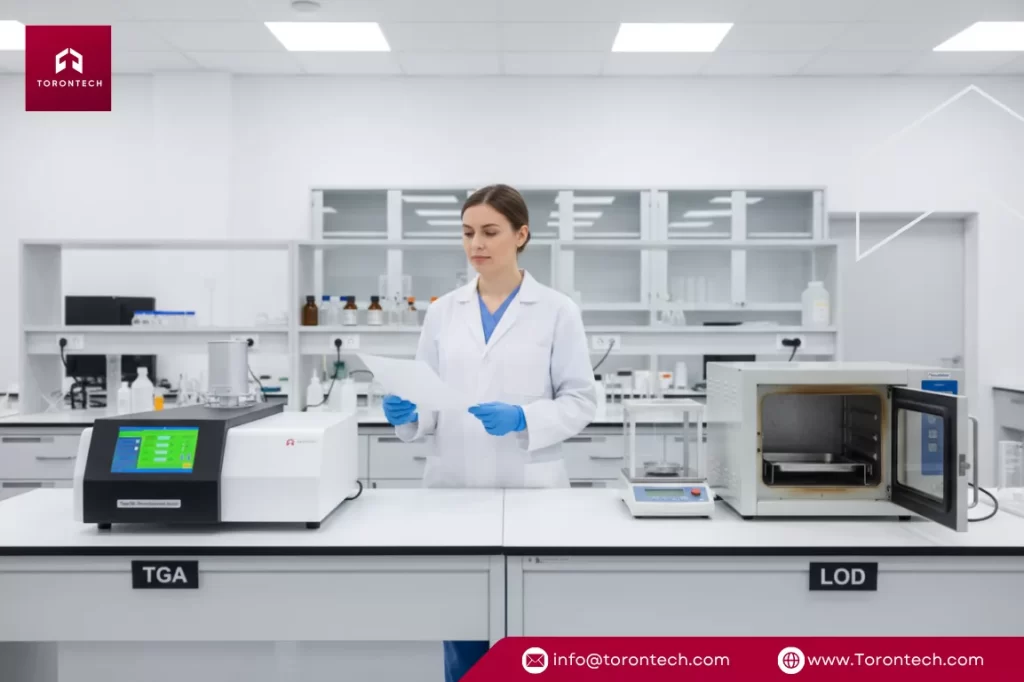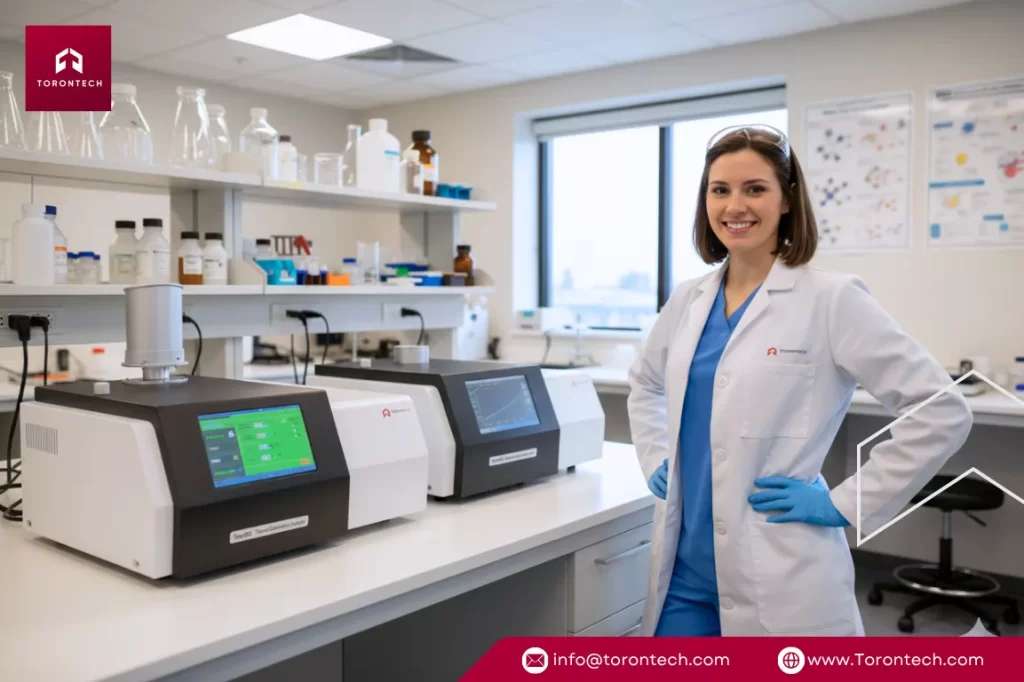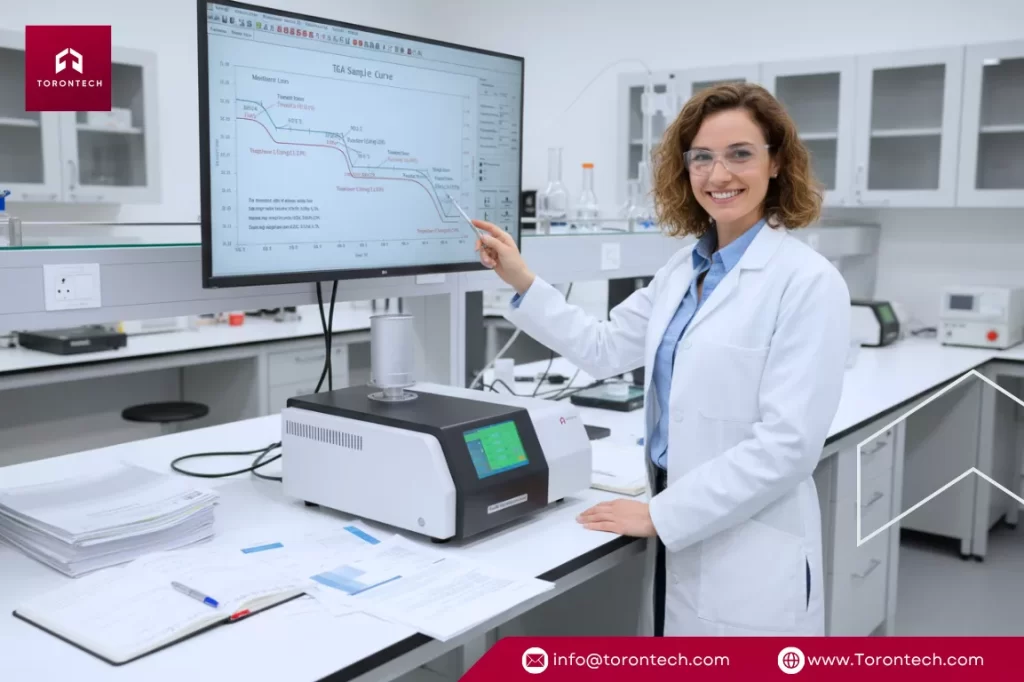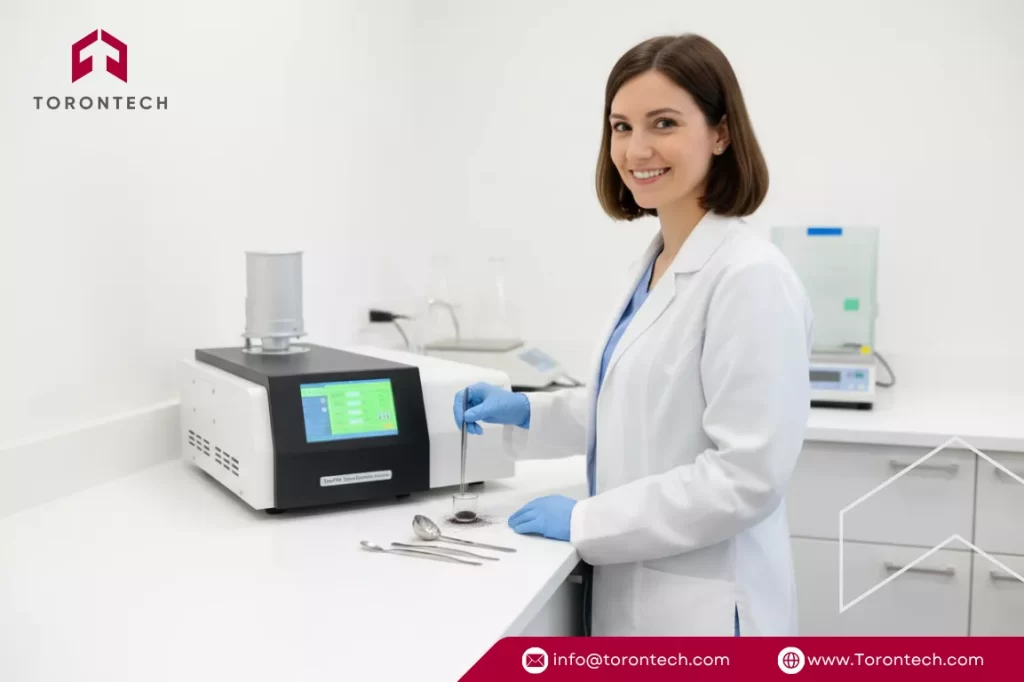Having a clear picture of what your materials are made of and how they behave under heat is foundational to creating a quality product. For this, two well-known methods are Thermogravimetric Analysis (TGA) and Loss on Drying (LOD).
This article will break down the thermogravimetric analysis vs loss on drying debate, helping you decide which method is right for you.
The Standard Method: What Loss on Drying (LOD) Shows You
Loss on Drying is a long-established, direct way to find out the volatile content in a sample, which is usually moisture. The procedure is straightforward: weigh a sample, heat it in an oven, and weigh it again. The amount of weight that has disappeared is your result.
The limitation here, however, is that LOD has a specific, narrow function. It only reports a total loss and can’t distinguish between water and other volatile substances.
This is a critical point to remember in any LOD vs TGA comparison, as it can lead to an incomplete picture and introduce a degree of uncertainty for complex materials.
A More Revealing Technique: Thermogravimetric Analysis (TGA)
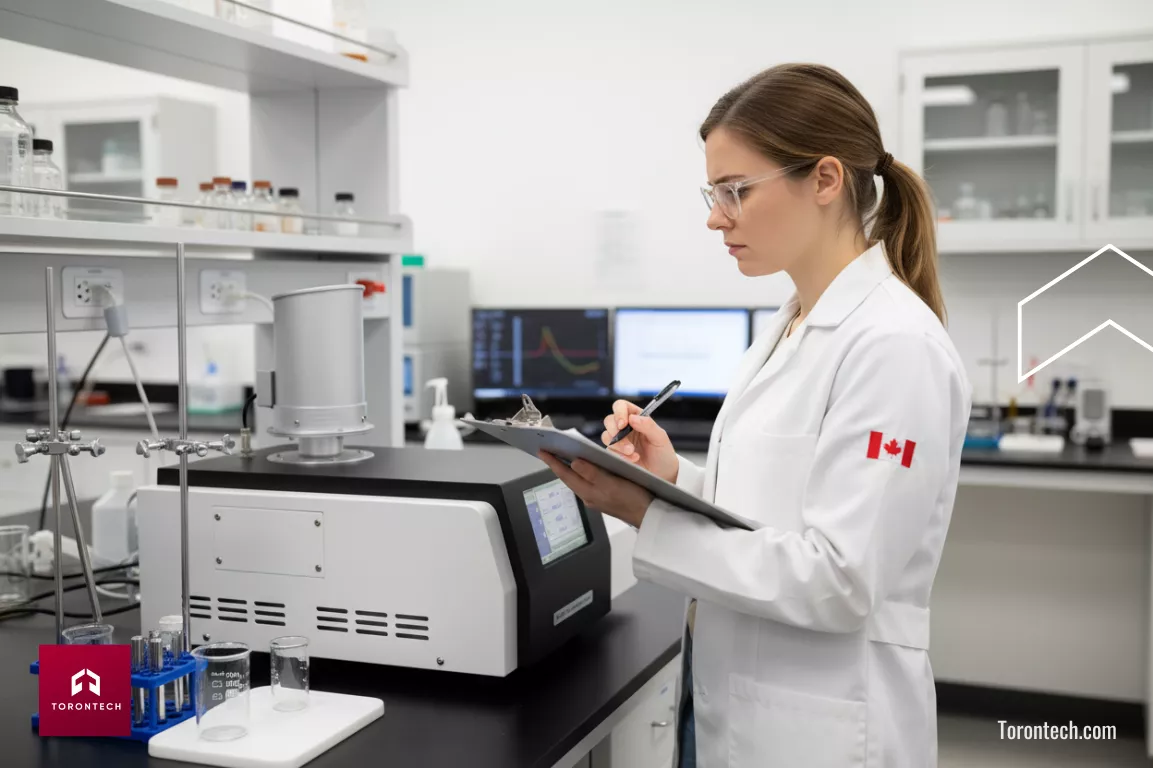
This is where we see Thermogravimetric Analysis (TGA) offer a significant advantage.
A high-fidelity TGA instrument, such as our ToronTGA, applies heat to a sample through a controlled program. All the while, it monitors the sample’s weight with exceptional precision, tracking every small change as it happens.
The result is not a single number, but a detailed TGA curve. This graph provides a full narrative of thermal events, showing the specific temperatures at which different components are released.
This is the core reason why the conversation around TGA vs LOD is so important for advanced industries.
Related article: DSC vs TGA: A Complete Guide to the Difference
The Direct Comparison: TGA vs. LOD
| Feature | Loss on Drying (LOD) | Thermogravimetric Analysis (TGA) |
| What It Measures | The total weight that disappears after heating. | A continuous profile of weight change as temperature rises. |
| The Info You Get | A single value for total volatile content. | A full thermal profile, identifying different stages of weight loss. |
| Getting Specific | Cannot tell water apart from other evaporating substances. | Offers high specificity, showing the unique temperatures where components are lost. |
| Controlling Heat | Uses one fixed temperature for the duration of the test. | Employs a programmed schedule of heating, cooling, or holding at temperature. |
| The Air Inside | Operates in the surrounding ambient air. | Uses a controlled gas atmosphere (like nitrogen or air) to study specific reactions. |
| Best For… | Verifying moisture content in basic raw materials. | In-depth analysis for R&D, QC, and process optimization of polymers, pharmaceuticals, etc. |
| Sample Needed | A larger quantity in the gram range. | A very small amount in the milligram range is sufficient. |
| The Price Tag | A lower initial equipment cost. | A larger initial investment that often yields a greater return in actionable data. |
Loss on Drying vs. Thermogravimetric Analysis: Practical Scenarios
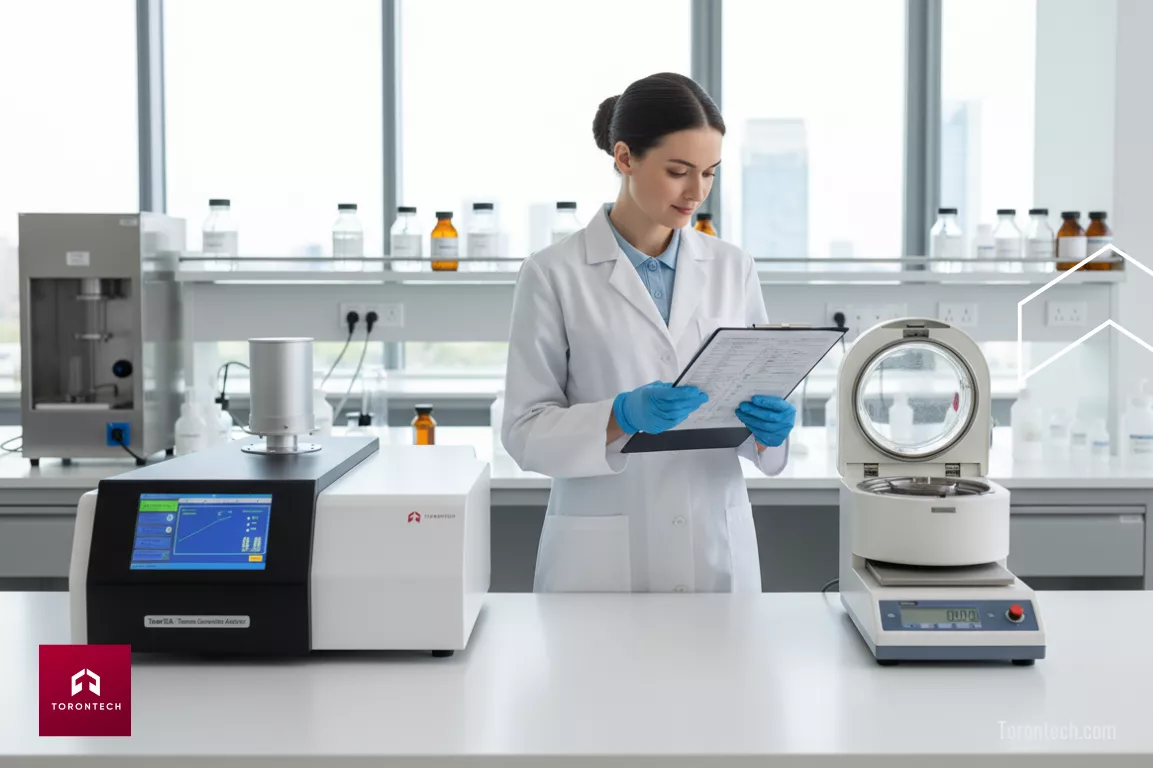
Choosing the correct technique comes down to the problems you need to solve. The decision between TGA and LOD becomes clear when you look at real-world applications.
Consider Loss on Drying (LOD) in these situations:
- For routine inbound checks. Imagine a food production facility receiving a large shipment of flour. They need a quick, simple pass/fail test to ensure the moisture content is below the 14% maximum. LOD is perfect for this. It’s fast, straightforward, and answers the one question they have: “Is this shipment within our moisture specification?”
- For basic material verification. A construction materials company buys sand and gravel in bulk. They use LOD to verify the free water content so they aren’t overpaying for water weight. The composition is simple, and they only need a single value.
You need Thermogravimetric Analysis (TGA) for more complex challenges:
- When troubleshooting a production failure. Let’s say a plastics company finds that a batch of molded car parts is brittle. A TGA analysis might show that the polymer starts to break down at a lower temperature than specified, or that a stabilizing additive is missing. It provides the detailed evidence needed to reject the raw material and prevent a costly production run.
- During new product development. An R&D lab is creating a new pharmaceutical tablet. When considering TGA and LOD, only TGA can provide the necessary detail. It can show them at what temperature the active ingredient degrades, if there’s any residual solvent, and how stable the binding agents are. This data is non-negotiable for safety and efficacy.
- To reverse-engineer or verify a competitor’s material. An automotive supplier wants to analyze a competitor’s brake pad. This kind of compositional analysis, a key strength of TGA, can help determine the percentage of organic compounds versus inorganic fillers by showing how much material remains as ash at very high temperatures.
Torontech: Your Cost-Effective TGA Solution
Ultimately, the choice between loss on drying vs thermogravimetric analysis depends on the level of detail your work requires.
Where LOD provides a single data point, TGA delivers a full spectrum of information. For any organization focused on innovation and strict quality control, the intelligence from TGA is invaluable.
We know that the cost of advanced analytical equipment can be a significant hurdle. Torontech was founded to address this issue by engineering cost-effective solutions that do not sacrifice performance. Our ToronTGA Thermogravimetric Analyzer was developed to provide this deeper insight without the prohibitive price tag. Its key features include:
- Exceptional Precision: A high-grade microbalance detects minute mass changes, ensuring your results are accurate and repeatable.
- Broad Temperature Application: With a range up to 1550°C, it is built to handle an extensive variety of materials.
- Intuitive Software: The system is paired with straightforward software for simple test setup and clear data interpretation.
- Cost-Effective Durability: It is a durable instrument, built for longevity and offered at a competitive price to make advanced analysis more accessible.
If you are ready to move from a single data point to a complete material profile, we are positioned to help. Contact us today to discuss our ToronTGA and learn how it can bring a new level of precision and value to your operations.
Want More Reliable TGA Results?
References:
- Bensharada, M., Telford, R., Stern, B., & Gaffney, V. (2021). Loss on ignition vs. thermogravimetric analysis: a comparative study to determine organic matter and carbonate content in sediments. Journal of Paleolimnology, 67, 191-197. https://doi.org/10.1007/s10933-021-00209-6
- Mansa, R., & Zou, S. (2021). Thermogravimetric analysis of microplastics: A mini review. Environmental Advances. https://doi.org/10.1016/j.envadv.2021.100117
- Moseson, D., Jordan, M., Shah, D., Corum, I., Alvarenga, B., & Taylor, L. (2020). Application and Limitations of Thermogravimetric Analysis to Delineate the Hot Melt Extrusion Chemical Stability Processing Window.. International journal of pharmaceutics, 119916. https://doi.org/10.1016/j.ijpharm.2020.119916
- Alves, C., Morenike, E., & Onwudili, J. (2022). Application of Thermogravimetric Analysis Method for the Characterisation of Products From Triglycerides During Biodiesel Production. Journal of Analytical and Applied Pyrolysis. https://doi.org/10.1016/j.jaap.2022.105766
- Cortés-Esquivel, J., Herrera-Silveira, J., & Quintana-Owen, P. (2023). Organic Matter Content in Mangrove Soils from a Karstic Environment: Comparison between Thermogravimetric and Loss-on-Ignition Analytical Techniques. Forests. https://doi.org/10.3390/f14071469
Frequently Asked Questions (FAQ)
1. What is the main difference between TGA and LOD?
The main difference is the level of detail each provides. Loss on Drying (LOD) measures the total weight lost after heating a sample, giving a single value that includes all volatile substances like water. Thermogravimetric Analysis (TGA), on the other hand, continuously measures the sample’s weight as the temperature increases, showing precisely when different components burn off. This allows TGA to distinguish between water, solvents, and the degradation of the primary material.
2. When should I use TGA instead of Loss on Drying?
You should use TGA instead of Loss on Drying when you need to understand a material’s thermal behavior or composition, not just its total moisture content. TGA is the superior choice for research and development, troubleshooting production issues, or analyzing complex materials like polymers, pharmaceuticals, and composites where identifying specific volatile components and degradation temperatures is critical.
3. Is TGA more accurate than LOD?
TGA provides a more specific and comprehensive analysis rather than being inherently more accurate. For a simple task like measuring total moisture in grain, LOD can be very accurate. However, if a material contains both water and a solvent, LOD’s single result would be misleading. In that scenario, TGA is more accurate because it can precisely quantify both the water loss and the solvent loss as separate events.
4. Can TGA measure moisture content like LOD does?
Yes, TGA is an excellent and often more precise method for measuring moisture content. A TGA analysis will clearly show a weight loss step around 100°C, which directly corresponds to the evaporation of water. A key advantage over LOD is its ability to confirm that the weight loss is only from water and not from other substances that might evaporate at slightly different temperatures.
5. What are the key applications of Thermogravimetric Analysis (TGA)?
The key applications for Thermogravimetric Analysis include determining the thermal stability of materials, analyzing the composition of composites and plastics (such as filler content), quantifying moisture and solvent content, and studying decomposition processes. TGA is an indispensable tool used across industries for quality control, failure analysis, and new product development.

